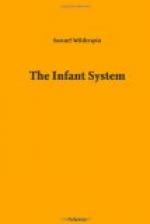Addition.
One of the children is placed before the gallery, and repeats aloud, in a kind of chaunt, the whole of the school repeating after him; One and one are two; two and one are three; three and one are four, &c. up to twelve.
Two and two are four; four and two are six; six and two are eight, &c. to twenty-four.
Three and three are six; six and three are nine; nine and three are twelve, &c. to thirty-six.
Subtraction.
One from twelve leaves eleven; one from eleven leaves ten, &c.
Two from twenty-four leave twenty-two; two from twenty-two leave twenty, &c.
Multiplication.
Twice one are two; twice two are four, &c. &c. Three times three are nine, three times four are twelve, &c. &c.
Twelve times two are twenty-four; eleven times two are twenty-two, &c. &c.
Twelve times three are thirty-six; eleven times three are thirty-three, &c. &c. until the whole of the multiplication table is gone through.
Division.
There are twelve twos in twenty-four.—There are eleven twos in twenty-two, &c. &c. There are twelve threes in thirty-six, &c. There are twelve fours in forty-eight, &c. &c.
Fractions.
Two are the half (1/2) of four. " " " third (1/3) of six. " " " fourth (1/2) of eight. " " " fifth (1/5) of ten. " " " sixth (1/6) of twelve. " " " seventh (1/7) of fourteen. " " " twelfth (1/12) of twenty-four; two are the eleventh (1/11) of twenty-two, &c. &c.
Three are the half (1/2) of six. " " " third (1/3) of nine. " " " fourth (1/4) of twelve.
Three are the twelfth (1/12) of thirty-six;
three are
the eleventh (1/11) of thirty-three, &c.
&c.
Four are the half (1/2) of eight, &c.
In twenty-three are four times five, and
three-fifths
(3/5) of five; in thirty-five are four
times eight, and three-eighths
(3/8) of eight.
In twenty-two are seven times three, and
one-third
(1/3) of three.
In thirty-four are four times eight, and
one-fourth
(1/4) of eight.
The tables subjoined are repeated by the same method, each section being a distinct lesson. To give an idea to the reader, the boy in the rostrum says ten shillings the half (1/2) of a pound; six shillings and eightpence one-third (1/3) of a pound, &c.
Sixpence the half (1/2) of a shilling, &c. Always remembering, that whatever the boy says in the rostrum, the other children must repeat after him, but not till the monitor has ended his sentence; and before the monitor delivers the second sentence, he waits till the children have concluded the first, they waiting for him, and he for them; this prevents confusion, and is the means of enabling persons to understand perfectly what is going on in the school.




